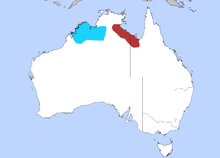Purple-crowned fairywren
| Purple-crowned fairywren | |
|---|---|
| | |
| Purple-crowned fairy-wren painting by John Gould | |
| | |
| Conservation status | |
| Scientific classification | |
| Kingdom: | Animalia |
| Phylum: | Chordata |
| Class: | Aves |
| Order: | Passeriformes |
| Family: | Maluridae |
| Genus: | Malurus |
| Species: | M. coronatus |
| Binomial name | |
| Malurus coronatus Gould, 1858 | |
 | |
| Distribution of the purple-crowned fairywren | |
The purple-crowned fairywren (Malurus coronatus) is a species of bird in the Maluridae family. It is endemic to northern Australia; two subspecies are recognized.
The surgeon J. R. Elsey was the first to collect the species, on A. C. Gregory's northern Australian expedition in 1855 and 1856. Two specimens were collected at Victoria River and a third at Robinson River which was not examined for over 100 years.[2] It was first described by the ornithologist John Gould in 1858. Its species name is derived from the Latin cǒrōna "crown".[3] The nominate subspecies is found in the Kimberley region of northwestern Australia, and the subspecies macgillivrayi. named by Gregory Mathews in 1913, from the lands bordering the Gulf of Carpentaria. The two subspecies are separated by around 200 km of land inhospitable to them, and has been for around 10,000 years.[2] Its distinctive plumage led Mathews to place it in a separate genus Rosina. However, genetic evidence shows it is most closely related to the superb and splendid fairywren within the genus Malurus.[4]
The plumage is brown overall, the wings more greyish brown. The bill and feet are black. The male in breeding plumage has a purple crown bordered by a black nape and face. On the top of the head is a black rectangular patch. It also has a cream-buff belly and blue tail tipped with white. In eclipse plumage the crown is grey and head mottled black and grey. The female differs in having a blue-tinged grey crown, chestnut ear-coverts, and greenish blue tail. Immature birds have a brown crown, although male birds start to show black feathers on the face by 6 to 9 months.[2]
Three calls have been recorded: a loud reel cheepa-cheepa-cheepa, a quieter chet – a contact call between birds in a group when foraging, and an alarm call – a harsh zit.[5]
The preferred habitat is long grass or Pandanus, within 10 m (35 ft) of a river or spring.[5]
References
- ↑ BirdLife International (2012). "Malurus coronatus". IUCN Red List of Threatened Species. Version 2013.2. International Union for Conservation of Nature. Retrieved 26 November 2013.
- ↑ 2.0 2.1 2.2 Rowley and Russell, p. 155.
- ↑ Simpson, D.P. (1979). Cassell's Latin Dictionary (5 ed.). London: Cassell Ltd. p. 153. ISBN 0-304-52257-0.
- ↑ Christidis L, Schodde R (1997). (abstract) "Relationships within the Australo-Papuan Fairy-wrens (Aves: Malurinae): an evaluation of the utility of allozyme data". Australian Journal of Zoology 45 (2): 113–129. doi:10.1071/ZO96068. Retrieved 2007-09-20.
- ↑ 5.0 5.1 Rowley and Russell, p. 156.
Cited text
- Rowley, Ian; Russell, Eleanor (1997). Bird Families of the World:Fairy-wrens and Grasswrens. Oxford: Oxford University Press. ISBN 0-19-854690-4.
| ||||||||||
